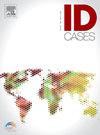A rare neurological complication of dengue: Guillain-Barré Syndrome in a dengue fever patient
IF 1.1
Q4 INFECTIOUS DISEASES
引用次数: 0
Abstract
Background
Dengue fever is a common viral illness in tropical and subtropical regions, typically presenting with fever, myalgia, and hemorrhagic symptoms. While neurological complications are rare, Guillain-Barré Syndrome (GBS) is a known but uncommon sequelae of viral infections, including dengue.
Case presentation
We report the case of a previously healthy 32-year-old male who developed acute flaccid paralysis secondary to GBS following a dengue fever infection. The patient initially presented with classic dengue symptoms—fever, severe headache, retro-orbital pain, and myalgia. Following resolution of the acute dengue phase, he developed ascending muscle weakness, areflexia, and numbness in both legs. Electromyography confirmed a diagnosis of GBS, and cerebrospinal fluid analysis revealed albuminocytologic dissociation. The patient was treated with intravenous immunoglobulin (IVIG), leading to significant clinical improvement, with gradual recovery of motor function.
Discussion
This case highlights the rare but significant neurological complication of GBS following dengue fever. Clinicians should maintain a high index of suspicion for GBS in patients recovering from dengue, especially in endemic regions. Early diagnosis and treatment with IVIG or plasmapheresis are critical for improving outcomes in these patients.
Conclusion
Dengue fever can lead to severe neurological sequelae such as GBS, and early recognition and intervention can prevent long-term disability. This case underscores the need for vigilance in identifying such complications in patients recovering from viral infections.
登革热罕见的神经系统并发症:登革热患者的格林-巴罗综合征
背景登革热是热带和亚热带地区常见的病毒性疾病,典型表现为发热、肌痛和出血性症状。虽然神经系统并发症很少见,但吉兰-巴罗综合征(GBS)是一种已知但不常见的病毒感染后遗症,包括登革热。我们报告一个先前健康的32岁男性在登革热感染后发展为继发于GBS的急性弛缓性麻痹的病例。患者最初表现为典型的登革热症状:发热、严重头痛、眶后疼痛和肌痛。急性登革期消退后,患者出现上升肌无力、反射屈曲和双腿麻木。肌电图证实了GBS的诊断,脑脊液分析显示白蛋白细胞分离。患者经静脉注射免疫球蛋白(IVIG)治疗,临床明显改善,运动功能逐渐恢复。本病例强调登革热后GBS罕见但显著的神经系统并发症。临床医生应对登革热康复患者的GBS保持高度怀疑,特别是在流行地区。早期诊断和IVIG或血浆置换治疗对于改善这些患者的预后至关重要。结论登革热可导致严重的神经系统后遗症,如GBS,早期识别和干预可预防长期残疾。这个病例强调了在从病毒感染中恢复的患者中识别此类并发症时需要保持警惕。
本文章由计算机程序翻译,如有差异,请以英文原文为准。
求助全文
约1分钟内获得全文
求助全文

 求助内容:
求助内容: 应助结果提醒方式:
应助结果提醒方式:


